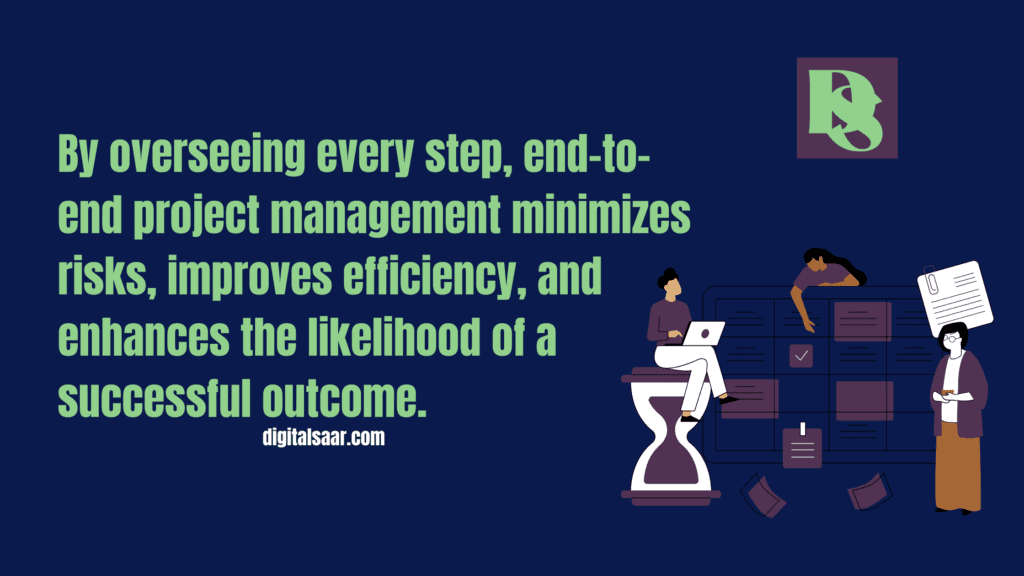Understanding what is end-to-end project management can be a game-changer for anyone looking to see a project through from start to finish. Think of it as guiding a project from its very first idea to the final delivery, ensuring that every detail is carefully planned and managed along the way. It’s not just about ticking off tasks—it’s about making sure every part of the project fits together smoothly, leading to a successful and well-executed outcome. In today’s world, this approach can make all the difference in delivering projects that truly stand out.
What is End-to-End Project Management?
End-to-end project management is a comprehensive approach that oversees every phase of a project, from its initial concept to its final completion. Unlike traditional project management, which may focus on specific stages or tasks, end-to-end management ensures that every aspect of the project is carefully planned, executed, and monitored.
What Are Key Elements Of End-To-End Project Management?
Initiation:
- Defining the project’s objectives, scope, and feasibility.
- Establishing a clear vision and setting the groundwork for success.
Planning:
- Creating detailed project plans, including timelines, resource allocation, and budgeting.
- Identifying potential risks and developing mitigation strategies.
Execution:
- Implementing the project plan, coordinating tasks, and managing teams.
- Ensuring that all deliverables are on track and meet the required quality standards.
Monitoring and Controlling:
- Continuously tracking the project’s progress against the plan.
- Making necessary adjustments to keep the project on course and within budget.
Closure:
- Finalizing all project activities and deliverables.
- Conducting a thorough review to ensure that all objectives have been met.
This approach is about more than just managing tasks; it’s about connecting every dot in the project lifecycle to ensure that the end result aligns perfectly with the original goals. A well-defined organizational structure impacts project management by shaping workflows, team collaboration, and decision-making processes. By overseeing every step, end-to-end project management minimizes risks, improves efficiency, and enhances the likelihood of a successful outcome.
What Are Benefits Of End-To-End Project Management?
End-to-end project management offers a range of advantages that can significantly enhance the success of a project. Here’s how:
- Holistic Approach:
- Provides a complete view of the project from start to finish, ensuring that nothing is overlooked.
- Facilitates better coordination between different phases, leading to smoother transitions and a more cohesive project.
- Risk Mitigation:
- Early identification and management of potential risks.
- Enables proactive adjustments to the plan, reducing the chances of delays or budget overruns.
- Improved Efficiency:
- Streamlines processes by integrating all stages of the project, reducing duplication of effort.
- Enhances resource allocation and utilization, ensuring that the right people and tools are in place at the right time.
- Clear Accountability:
- Establishes clear roles and responsibilities for each phase of the project.
- Ensures that everyone involved knows what is expected of them, leading to more effective teamwork.
- Better Communication:
- Fosters continuous communication across all project stages, helping to keep stakeholders informed and engaged.
- Reduces misunderstandings and ensures that everyone is aligned with the project’s goals.
- Higher Quality Outcomes:
- By managing the project comprehensively, quality control is maintained throughout the process.
- Results in a final deliverable that meets or exceeds expectations.
- Enhanced Flexibility:
- Allows for adjustments and iterations during the project without losing sight of the overall objectives.
- Makes it easier to adapt to changes in scope or unforeseen challenges.
End-to-end project management is not just about completing tasks; it’s about ensuring that every part of the project contributes to a successful and high-quality final outcome. By adopting this approach, organizations can improve their project success rates and deliver results that truly stand out.

What Are The Challenges Of End-To-End Project Management?
While end-to-end project management offers numerous benefits, it also comes with its own set of challenges that need to be carefully managed:
- Complexity:
- Managing an entire project lifecycle involves handling numerous tasks, stakeholders, and resources simultaneously.
- Keeping track of every detail can be overwhelming, especially in large or multi-phase projects.
- Resource Intensive:
- Requires significant time, effort, and resources to plan and execute effectively.
- Allocating and managing these resources efficiently is crucial to avoid burnout or resource wastage.
- High Dependency on Leadership:
- Success heavily relies on strong leadership to coordinate various teams and ensure everyone stays aligned with the project goals.
- Lack of effective leadership can lead to miscommunication, delays, and a loss of focus.
- Unforeseen Changes:
- Projects can be disrupted by unexpected changes in scope, market conditions, or stakeholder expectations.
- Adapting to these changes while maintaining the project’s overall integrity can be challenging.
- Communication Barriers:
- With multiple teams and stakeholders involved, ensuring clear and consistent communication is vital.
- Miscommunication or information silos can lead to misunderstandings, errors, and delays.
- Balancing Scope and Flexibility:
- While it’s important to maintain the project’s original scope, being too rigid can hinder adaptability.
- Finding the right balance between staying on track and allowing for necessary changes is a common challenge.
- Pressure to Deliver High-Quality Results:
- The comprehensive nature of end-to-end project management often sets high expectations for the final outcome.
- Meeting these expectations requires meticulous planning, execution, and constant monitoring.
- Longer Timeframes:
- Managing all aspects of a project can lead to longer timelines, particularly if issues arise that require revisiting earlier phases.
- This can be a challenge when working with tight deadlines or in fast-paced industries.
Addressing these challenges requires careful planning, effective communication, and a flexible yet disciplined approach to managing the project’s various elements. By anticipating and preparing for these obstacles, project managers can better navigate the complexities of end-to-end project management.
What Are The Best Practices For End-To-End Project Management?
To ensure the success of a project from start to finish, adopting these best practices in end-to-end project management can make a significant difference:
- Clear Goal Setting:
- Define clear and achievable objectives from the outset.
- Ensure that all stakeholders understand and agree on the project’s goals and desired outcomes.
- Comprehensive Planning:
- Develop a detailed project plan that outlines timelines, resources, BAC, and key milestones.
- Incorporate risk management strategies to anticipate potential challenges and create contingency plans.
- Effective Communication:
- Establish open and consistent communication channels among all team members and stakeholders.
- Regularly update everyone on the project’s progress, changes, and any issues that arise.
- Strong Leadership and Governance:
- Assign a project manager who can lead with clarity, making decisive actions while keeping the project on track.
- Implement governance structures to oversee the project’s progress and adherence to the plan.
- Use of Project Management Tools:
- Leverage project management software to track tasks, timelines, and resource allocation.
- Utilize tools that enable real-time collaboration, reporting, and documentation.
- Regular Monitoring and Review:
- Continuously monitor the project’s progress against the plan, making adjustments as necessary.
- Schedule regular review meetings to assess performance, address any issues, and keep the project aligned with its goals.
- Risk Management:
- Identify potential risks early in the project and develop strategies to mitigate them.
- Regularly reassess risks throughout the project lifecycle to stay ahead of potential problems.
- Flexibility and Adaptability:
- Be prepared to adapt the project plan in response to changes in scope, market conditions, or stakeholder needs.
- Maintain a flexible approach while ensuring that the project stays aligned with its overall objectives.
- Stakeholder Engagement:
- Involve stakeholders at every stage of the project to ensure their needs and expectations are met.
- Foster a collaborative environment where feedback is encouraged and acted upon.
- Quality Control:
- Implement quality assurance processes to maintain high standards throughout the project.
- Regularly test and review deliverables to ensure they meet the required specifications and quality levels.
- Continuous Improvement:
- After project completion, conduct a thorough review to identify lessons learned.
- Use these insights to improve processes and approaches for future projects.
Conclusion
End-to-end project management is more than just a process; it’s a strategic approach that ensures every aspect of a project is carefully managed from start to finish. By embracing this comprehensive method, you can minimize risks, improve efficiency, and deliver results that truly align with your goals. Whether you’re managing a small project or a large-scale initiative, the principles of end-to-end project management can help you achieve success with confidence.
If you found this guide helpful, don’t forget to share it with your network, leave a comment with your thoughts, and like this post.





